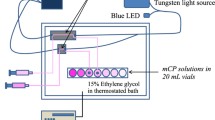Abstract
Calibration of pH meters is usually performed with reference pH buffer solutions of low ionic strength, I ≤ 0.1 mol kg−1. For seawater pH measurements (I ≈ 0.7 mol kg−1), calibration buffers in high ionic strength matrix are required. The Harned cell, in association with the Nernst equation and a model for estimating the chloride ion activity coefficient, \(\gamma_{{{\text{Cl}}^{ - } }} ,\) is the basis of the primary method for pH assignment to reference pH buffers. The semi-empirical Pitzer model is, in principle, adequate to estimate \(\gamma_{{{\text{Cl}}^{ - } }}\) of complex solutions, namely seawater. Nevertheless, no assessment of the validity of the model for this matrix is known to the authors. This work aims at estimating the adequacy of the Pitzer model by assessing the metrological compatibility of mean activity coefficients, in this case \(\gamma_{ \pm } = \sqrt {\gamma_{{{\text{H}}^{ + } }} \gamma_{{{\text{Cl}}^{ - } }} }\) estimated experimentally with the Harned cell, \(\gamma_{ \pm }^{\text{Exp}} ,\) and using the Pitzer model, \(\gamma_{ \pm }^{\text{Ptz}}\). The measurement uncertainty considered in the compatibility test was estimated using the bottom-up approach, where components were combined by the numerical Kragten method after checking its adequacy. The compatibility of the estimated \(\gamma_{ \pm }\) was assessed for solutions with increasing complexity and an ionic strength of 0.67 mol kg–1. \(\gamma_{ \pm }^{\text{Exp}}\) and \(\gamma_{ \pm }^{Ptz}\) are metrologically compatible for a confidence level of 95 % where the relative standard uncertainty of their difference ranged from 1.1 % to 3.1 % in all chloride solutions to approximately 6.3 % when sodium sulfate was also present. This led to assume the validity of the Pitzer model equations to estimate \(\gamma_{{{\text{Cl}}^{ - } }} ,\) required to define reference pH values of buffer solutions with high ionic strength.



Similar content being viewed by others
References
DelValls TA, Dickson AG (1998) The pH of buffers based on 2-amino-2-hydroxymethyl-1,3-propanediol (“tris”) in synthetic sea water. Deep Sea Res I 45:1541–1554
MacInnes DA (1919) The activities of the ions of strong electrolytes. J Am Chem Soc 41(7):1086–1092
Guiomar MJ, Lito HM et al (2003) Effect of citrate impurities on the reference pH value of potassium dihydrogen buffer solution. Anal Chim Acta 482–1:137–146
Buck RP et al (2002) IUPAC recommendations 2002 measurement of pH. Definition, standards, and procedures. Pure Appl Chem 74:2169
Bates RG (1973) Determination of pH. Wiley, New York
Robinson RA, Stokes RH (1959) Electrolyte solutions, 2nd edn. Academic Press, New York, p 468
Pitzer KS (1973) Thermodynamics of electrolytes. I. Theoretical basis and general equations. J Phys Chem 77:268–277
Pitzer KS, Mayorga G (1973) Thermodynamics of electrolytes. II. Activity and osmotic coefficients for strong electrolytes with one or both ions univalent. J Phys Chem 77:2300–2308
Pitzer KS, Mayorga G (1974) Thermodynamics of electrolytes. III. Activity and osmotic coefficients for 2–2 electrolytes. J Solut Chem 3:539–546
Pytkowicz RM (1979) Activity coefficients in electrolyte solutions, vol I. CRC Press, Boca Raton, pp 157–208
Mendonça AJG, Vaz MM, Ferra MIA (2001) Determination of Pitzer parameters for sodium benzoate at 298.15 K. Portugaliae Electrochim Acta 19:73–82
JCGM 200:2012 (2012) International vocabulary of metrology—Basic and general concepts and associated terms (VIM), 3rd edition, BIPM, Paris. http://www.bipm.org/en/publications/guides/vim.html
Ricardo JN, da Silva Bettencourt, Santos Júlia R, Filomena M, Camões GFC (2006) A new terminology for the approaches to the quantification of the measurement uncertainty. Accred Qual Assur 10:664–671
Kragten J (1994) Calculating standard deviations and confidence intervals with a universally applicable spreadsheet technique. Analyst 119:2161–2166
Christian GD (2004) Analytical chemistry, 6th edn. John Wiley and Sons Inc, Hoboken
Ives DJ, Janz GJ (1961) Reference electrodes, theory and practice. Academic Press, New York
Guiomar Lito MJ, Filomena Camões M (2009) Meeting the requirements of the silver/silver chloride reference electrode. J Solut Chem 38:1471–1482
Brown R, Milton M, Brewer P, Wielgosz R (2001) High accuracy titrimetry with application to HCl. National physical laboratory report COAM 5
Mohr PJ, Taylor BN, Newell DB (2012) CODATA recommended values of the fundamental physical constants: 2010. National Institute of Standards and Technology, Gaithersburg
Wieser ME et al (2013) Atomic weights of the elements 2011(IUPAC technical report). Pure Appl Chem 85–5:1047–1078
Pytkowicz RM (1979) Activity coefficients in electrolyte solutions, vol II. CRC Press, Boca Raton
Harvie CE, Moller N, Weare JH (1984) The prediction of mineral solubilities in natural waters: the Na–K–Mg–Ca–Cl–SO4–H2O systems from zero to high concentration at 25 °C. Geochim et Cosmochim Acta 44:981–997
Waters JF, Millero FJ (2013) The free proton concentration scale for seawater pH. Mar Chem 149:8–22
Acknowledgments
This work was financially supported by the EMRP—ENV 05 OCEAN and the associated REG2. The EMRP is jointly funded by the EMRP participating countries within EURAMET and the European Union. The authors wish to acknowledge the Portuguese funding institution Fundação para a Ciência e a Tecnologia-FCT, for supporting their research, namely through project PEst-OE/QUI/UI0612/2013.
Author information
Authors and Affiliations
Corresponding author
Rights and permissions
About this article
Cite this article
Anes, B., Bettencourt da Silva, R.J.N., Martins, H.F.P. et al. Compatibility of activity coefficients estimated experimentally and by Pitzer equations for the assessment of seawater pH. Accred Qual Assur 21, 1–7 (2016). https://doi.org/10.1007/s00769-015-1163-y
Received:
Accepted:
Published:
Issue Date:
DOI: https://doi.org/10.1007/s00769-015-1163-y




